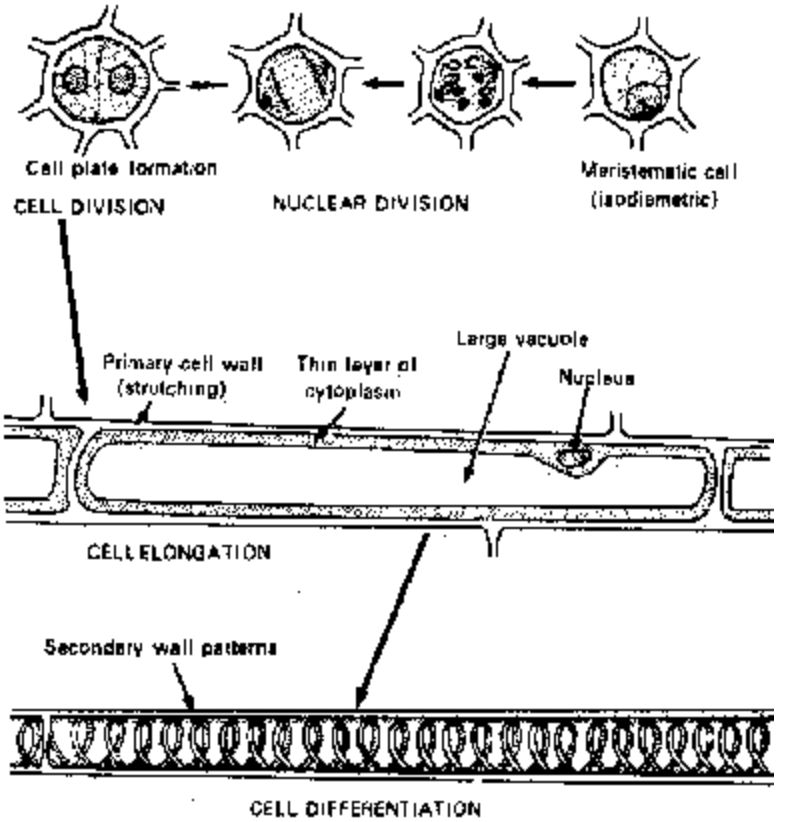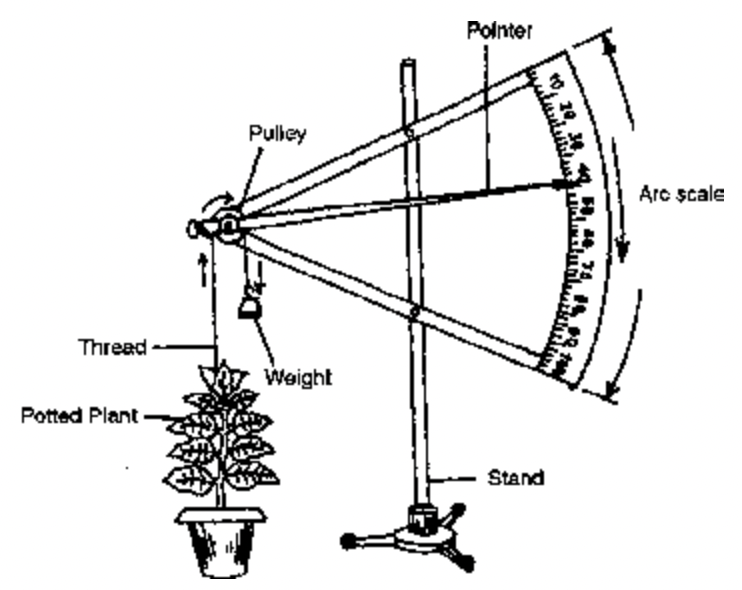
Role of Meristems in growth
Plant Growth And Development of Class 11
On the basis of their position in the plant body (higher plants) meristems are divided into three main categories.
- Apical meristems
- Intercalary meristems
- Lateral meristems
Apical meristems : These meristems are found at shoot and root apex. As a result of activity of these meristems plant increases in length.
Intercalary meristems : These meristems are found above and below the nodes. As a result of the activity of these meristems increase in length takes place., e.g. Bambusa.
Lateral meristems : Increase in girth of shoots and roots take place because of the activity of this cambium.
e.g., cork cambium and vascular cambium.
The physiological change taking place during the cell division, cell enlargement and cell differentiation (maturation) are as follows–

Fig. : Figure showing cell formation, cell elongation and cell differentiation
Cell division— A cell is metabolically highly active at the time of cell division. Its cellular mass increases and replication of genetic material (nucleic acids) takes place. Growth as a result of division is based on mitotic cell division. In the stage of mitosis each chromosome is split lengthwise into two homologous chromatids which pass equally into daughter cells. As a result of division each cell is only half the size of parent cell. These cells then proceed to enlarge.
Cell enlargement— Cell division is followed by cell enlargement. The cell increases in size due to vacuolation (by absorption of water). A big central vacuole appears which pushes the cytoplasm to be limited to a thin boundary layer against the cell wall. The new cell material is synthesized to cope with the enlargement.
Cell differentation— Cell differentiation following cell division and cell enlargement leads to the development of specialized mature tissue cell, e.g. some cells are differentiated into xylem tracheids and trachea and some others into sieve tubes and companion cells.
Besides growth and differentiation a plant also undergoes development. Development is the sequence of events that occurs in the life history of a cell, organ or organism which includes growth, differentiation, maturation and senescence. Senescence or old age leads to death.
Development is of two types :
Homoblastic development : A gradual transition from Juvenile to adult phase is called Homoblastic development, e.g., Ipomoea, Delphinium.
Heteroblastic development : An abrubt change from Juvenile to adult phase is called heteroblastic development, e.g., Hedera (Ivy).
Thus growth in plants is a complex phenomenon which involves a number of metabolic and genetical processes.
However, growth in plants finds no parallel with growth in animals because:
Growth in plants takes place more or less throughout the life while in animals it is limited in relation to age.
In plants growth zones are restricted to some specialized regions called meristems while in animals growth zones are distributed throughout the body.
The plant growth can be measured in terms of :
Increase in volume
Increase in weight
Increase in height or diameter
Increase in area, etc.
Course of Growth
- Lag Phase. Very slow growth
- Log Phase. Rapid growth, also called exponential phase or grand phase of growth.
- Phase of Diminishing Growth. Growth again becomes slow.
- Stationary Phase. Growth stops completely or continues at a slow rate.
The total time taken by a cell or organ in completing all the above given three phases is called Grand period of growth curve.
Measurement of growth
Growth in plants can be measured in terms of
- Increase in the number of cells produced
- Increase in the length or girth of a shoot or root
- Increase in the dry weight of organ and increase in the area of a leaf and volume of a fruit.
Growth can be measured by
- Marking at equal internals with India ink (first done by Sachs)
- Auxanometer : an instrument used to measure growth its of two types; Arc’s and Pfeffer’s.

Fig. Arc Auxanometer
- Crescograph : A sensitive apparatus for measuring growth developed by Sir J.C.Bose.
- Horizontal microscope : It is used to measure growth usually in the field.









